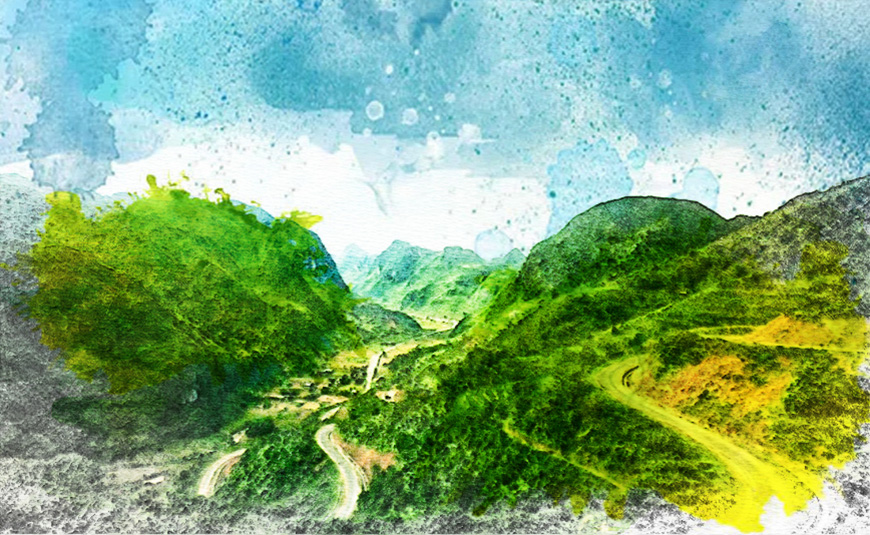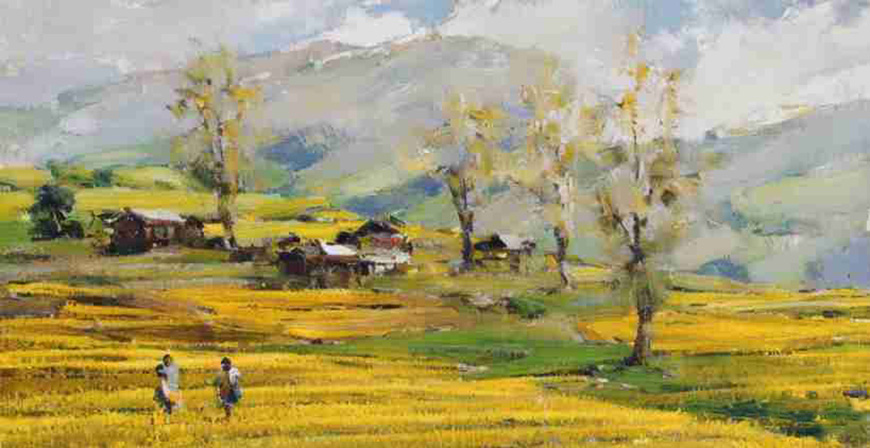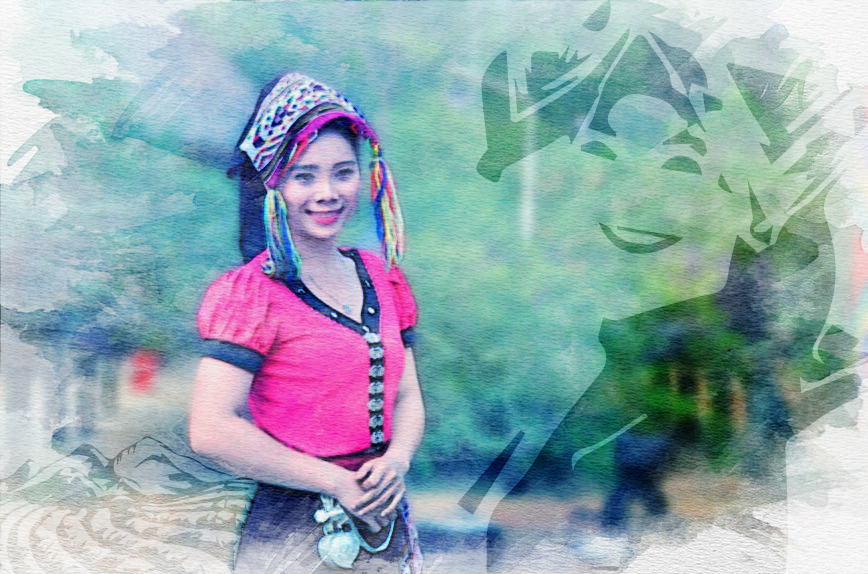 Pha Din Pass - Artistic view by Sebastien G. Mixed media
Pha Din Pass - Artistic view by Sebastien G. Mixed mediaThe call of the unknown in Dien Bien
Dien Bien, a mountainous province in Northwest Vietnam, is often associated with its historical significance, particularly the decisive victory in 1954 that marked the end of French colonial rule in Indochina. However, beyond its military past, Dien Bien is a destination rich in unexplored natural wonders and authentic cultural experiences. Located approximately 450 km from Hanoi, and sharing borders with China and Laos, its strategic position has shaped its unique character and spectacular landscapes. The rugged terrain, remote villages, and ethnic diversity offer unparalleled opportunities for adventure tourism and deep cultural immersion.
 Landscape on the road to Dien Bien - Artistic view by Walter F. Gouache on wood
Landscape on the road to Dien Bien - Artistic view by Walter F. Gouache on woodGeography & climate
Dien Bien Phu is situated in a vast, fertile basin, the Muong Thanh Valley, measuring approximately 18 km long by 6 to 8 km wide, and surrounded by lush green mountains. This plain is essential for local agriculture, especially rice cultivation. Dien Bien's terrain is mostly mountainous, crisscrossed by a dense network of rivers. The climate is a high-mountain tropical monsoon type, with cold, dry winters (October to April) and hot, rainy summers (May to August). The months of March-April and August-September are ideal for exploration due to the sunshine.
Beyond the Muong Thanh Valley and Pha Din Pass, Dien Bien is home to more isolated gems:
A Pa Chai extreme point
The westernmost point of Vietnam, this is a unique tri-border point with Laos and China. Reaching Border Marker Zero, at over 1,800 meters above sea level, is a challenging adventure.
Tua Chua karst plateau
This mountainous region is characterized by impressive limestone formations and ancient pine forests, offering panoramic views and cloud-gazing opportunities. Mysterious caves and an ancient Shan Tuyet tea forest can also be found there. The Da River winds through it, offering opportunities for boat trips or kayaking.
Muong Nhe nature reserve
This sanctuary of exceptional biodiversity offers authentic and little-touristed exploration, with waterfalls, primary forests, and cloud-gazing opportunities.
Pa Khoang lake and its sacred forest
Located about twenty kilometers from Dien Bien Phu, this artificial lake is surrounded by dense jungle and rich biodiversity. The surrounding forest is considered sacred by the Thai and Kho Mu populations.
 Thai woman from Dien Bien - Watercolor by Pierre L.
Thai woman from Dien Bien - Watercolor by Pierre L.Ethnic and cultural diversity
Dien Bien is a true living museum of Vietnamese cultural diversity, home to 19 different ethnic groups, including the Thai, H'mong, Dao, Kho Mu, Giay, Lu, and Si La. Each group has its own language, customs, traditional clothing, and festivals. Traditional stilt houses bear witness to this heritage.
For an authentic immersion, homestays are available in several villages:
- Long Village: Inhabited by the Mong ethnic group, it offers opportunities for cultural immersion.
- Tia Lo Village: Residents have renovated their homes to welcome travelers.
- Chuyen Gia 2 Village: A Dao village renowned for cloud-gazing and homestays
Cultural diversity is fully expressed during numerous lively festivals and markets:
- Ban Flower Festival: A major annual cultural event in spring, with music, traditional dances (such as the Xoe Thai dance, a UNESCO heritage), and mountain cuisine.
- H'Mong Gau Tao and Thai Xen Ban Festivals: Key moments in local life.
- A Pa Chai Market (or Sin Thau): Lively on the 3rd, 13th, and 23rd of each month, it is a center for commercial and cultural exchanges for border communities.
- Tua Chua Markets: Include weekly night markets and local markets like Ta Sin Thang and Xa Nhe, important for the H'Mong community.
.jpg) Dien Bien Phu Victory Monument - A Black pencil on vellum from Alexandra B.
Dien Bien Phu Victory Monument - A Black pencil on vellum from Alexandra B.History
Dien Bien Phu is globally known for the Battle of 1954, a key moment in the Indochina War that marked the end of French colonization in Vietnam. This 56-day and night battle was one of the deadliest of the post-World War II era. The Vietnamese victory triggered a wave of decolonization in Asia and around the world. The unique topography of the basin, with its fertile central plain surrounded by hills, was a determining strategic factor for the Viet Minh.
Adventure tourism: exploring the unexplored
Dien Bien, with its rugged landscapes and isolated communities, offers an exceptional playground for travelers seeking authentic adventures.
- Trekking and immersive hikes: Routes combine wild nature and cultural immersion, including three-day treks in Thai, H'mong, and Dao villages, hiking to the Noong U mountain lake, exploring the Tua Chua Karst Plateau, and conquering A Pa Chai.
- Bicycle rides: An excellent way to explore the surroundings of Dien Bien Phu, terraced rice fields, and isolated villages.
- Cultural and culinary discoveries: Homestays allow participation in the daily lives of Thai or H'mong communities, discovering their handicrafts, rituals, and traditional cuisine. Local markets are lively places to meet ethnic groups and discover local products.
Dien Bien off the beaten path: practical information
Exploring Dien Bien "off the beaten path" requires careful planning. Local guides are essential for safety and authentic experiences. Access to remote areas is often by jeep, motorbike, or on foot. Accommodation options include traditional homestays in isolated villages, offering deep cultural immersion.
Dien Bien: an exceptional destination to discover off-road
Dien Bien is an exceptional destination for those looking to get away from classic tourist routes, offering magnificent landscapes, rich living culture, and authentic adventure opportunities.
Illustrations : Thanks to our talented customers!